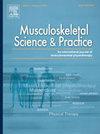Physical inactivity is the most important unhealthy lifestyle factor for pain severity in older adults with pain: A SHARE-based analysis of 27,528 cases from 28 countries
IF 2.2
3区 医学
Q1 REHABILITATION
引用次数: 0
Abstract
Background
Limited knowledge exists on the association between lifestyle factors and pain severity in older adults.
Objective
To assess the associations between unhealthy lifestyle variables and pain severity in the European population of older adults with pain.
Design
Cross-sectional.
Methods
Data were retrieved from the ninth wave of the Survey of Health, Ageing and Retirement in Europe (SHARE), a representative survey of individuals aged >50 years living in 27 European countries and Israel. Associations between lifestyle factors (sleep, smoking, diet and physical inactivity) and pain severity (mild, moderate, severe) were assessed using multivariable multinomial regression adjusted for age, sex, geographic region, education, history of chronic disease and mutually adjusted for each lifestyle.
Results
27,528 cases were included (73.1 ± 9.76 years; 63.3% female). A significant association was observed between those who hardly ever or never engaged in activities that required a moderate level of energy and severe pain (OR: 4.35; 95% CI: 3.85 to 4.92). Sleep problems (OR: 1.83; 95% CI: 1.69 to 1.99), smoking (OR: 1.21; 95% CI: 1.13 to 1.34) and an inadequate diet (OR: 1.78: 95% CI: 1.22 to 2.61) were also significantly associated with severe pain, but with lower odds. Given the cross-sectional design, the bidirectionality of these relationships should be considered.
Conclusion
Physically inactive older adults were particularly more likely to experience severe pain, while other lifestyle factors were more weakly associated with pain. As these lifestyle factors are modifiable, the results may be useful in prioritising appropriate preventive measures to attenuate pain and ensure healthy ageing.
求助全文
约1分钟内获得全文
求助全文
来源期刊

Musculoskeletal Science and Practice
Health Professions-Physical Therapy, Sports Therapy and Rehabilitation
CiteScore
4.10
自引率
8.70%
发文量
152
审稿时长
48 days
期刊介绍:
Musculoskeletal Science & Practice, international journal of musculoskeletal physiotherapy, is a peer-reviewed international journal (previously Manual Therapy), publishing high quality original research, review and Masterclass articles that contribute to improving the clinical understanding of appropriate care processes for musculoskeletal disorders. The journal publishes articles that influence or add to the body of evidence on diagnostic and therapeutic processes, patient centered care, guidelines for musculoskeletal therapeutics and theoretical models that support developments in assessment, diagnosis, clinical reasoning and interventions.
 求助内容:
求助内容: 应助结果提醒方式:
应助结果提醒方式:


